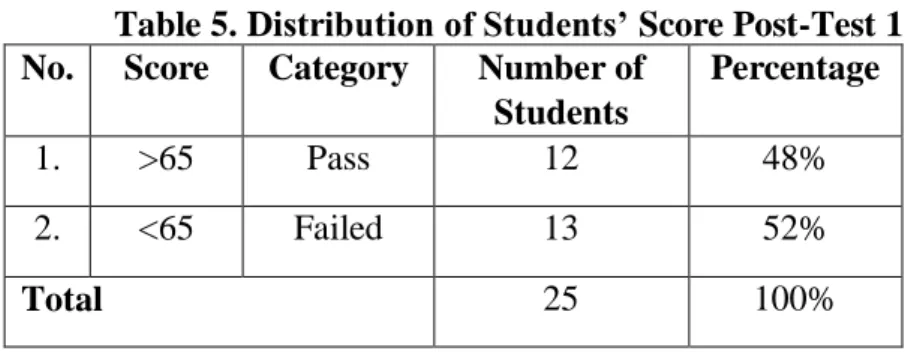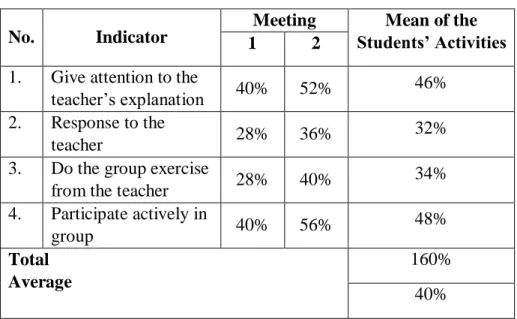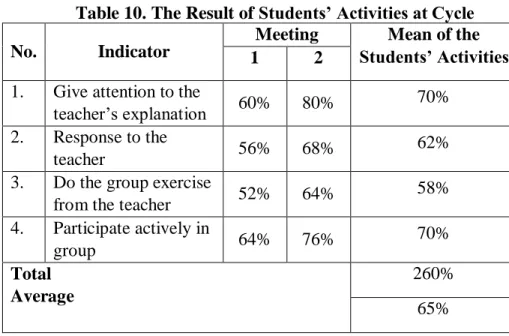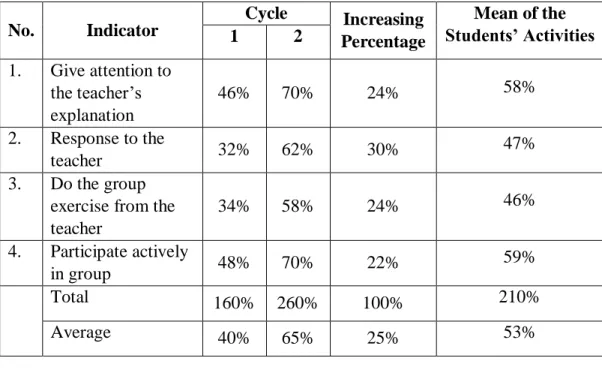The purpose of this research is to find out if the use of Student Team Achievement Division (STAD) technique can increase the students' speaking ability. In this research, the students were given pre-test before treatment and post-test after treatment. The finding result of this research: the result of pre-test, it showed that the students' average score was 55.52, there were 7 students who passed the minimum requirement (MCQ).
Technique
Speaking skill
The reason choosing of the title
Background of study
In cooperative learning, students work together in a group or pair to successfully achieve goals. So that students can maximize their own learning and that of each other.4 There is a technique of collaborative learning that can be applied in the classroom. Hopefully, by using the Student Team Achievement Division, the STAD technique can help students improve their English learning outcome, especially in speaking. TenGrades of the SMK YPI II Way Jepara East Lampung.
Research Problem
Problem Limitation
Problem Formulation
The Objecive and Benefits of study .1 The objectives
The benefits of Study
To provide information to English teachers if the Student Team Achievemnt Division (STAD) can increase the teaching of speaking. This chapter presents the review of literature related to the study, the review includes the definition of coherence, the concept of grammatical coherence, the concept of bachelor's thesis and the concept of abstract.
Theoretical Review
Teaching Speaking
The average person produces tens of thousands of words per day.4 In addition, speaking is generally considered to be the main skill that implies general knowledge of a foreign language.5. It is not speaking.6 Moreover, speaking is perhaps the most challenging skill a teacher has to teach. Speaking is one of the most important skills, because speaking and a person cannot be separated from each other.
Talk as Interaction
Three-part version of speech functions; conversation as interaction, conversation as transaction and conversation as performance.
Talk as Transaction
Talk as Performance
- The Elements of Speaking
- The Difficulties of Speaking
- Speaking Ability
- Teaching Speaking
Most of the speaking takes place in the form of face-to-face dialogue and therefore involves interaction.9 The speaking activities involve the students' interaction with the others and understanding each other. In Student Team Achievement Division (CITY), students within a given class are assigned to learning teams of four or five members. Slavin said in his book “Cooperative Learning: Theory, Research and Practice” that two of the oldest and most extensively researched forms of cooperative learning are Student Teams Achievement Division (CITY) and Teams Games Tournaments (TGT).16 In addition, in Students Team Achievement Division (CITY) applied by Sasha Haris, the students have a high and a low score in a pairing group consisting of five or six members and a team scores based on the students who can increase their quiz score.17.
Quiz scores are translated into team scores using “Achievement Division”.18 According to Slavin in journal, students in STAD are assigned to learning teams of four members, mixed in achievement level, gender and ethnicity. In addition, Student Team Achievement Division (CITY) allows students to learn in heterogeneous groups using cooperative learning procedures and holds students accountable with a quiz. From the various statements above, the writer summarizes that the Student Team Achievement Division (CITY) is one of the cooperative learning techniques that students are assigned to learning teams of four or five members that are mixed in achievement level, gender, and ethnicity.
Slavin stated in his book "cooperative learning" that the Student Team Achievement Division (STAD) consists of five main components, they are:. 1) Class presentation. Based on the explanation above, the writer summarizes that the major of Students Team Achievement Division (STAD) is integrated with each other.21. The general procedures generally followed when using the STAD (Student Team Achievement Division) technique are as follows: . 1) Preparation of the materials.
Materials are designed specifically for the Student Team Achievement Division (STAD) and are adapted from textbooks or other published resources or teacher-made materials. 2) Assignment of students to teams. From the details given above, the writer summarizes it before implementing the Student Team Achievement Division (STAD) in the classroom. Below are the steps in teaching speaking using the Student Team Achievement Division (STAD):
Step 1
Step 2
The goal that you want the students to learn actively, demonstrate concepts using many examples, often the students have grasped the main idea.
Step 3
The goal that you want the students to learn actively, demonstrate concepts using many examples, often the students have grasped the main idea. c) Guided practice.
Step 4
Step 5
Step 6
- Action Hypothesis
- Setting and Subject of the Study
- Object of the Study
- Action Plan
- Action Procedures .1 Planning step
- Acting step
- Observing step
- Reflecting step
- Research instrument
- Observation
- Test
- Documentation
- Field Note
- Indicator of Success
- General Description of Research Location .1 Brief History of The School
The subjects of the research were the tenth grade students of SMK YPI II Way Jepara East Lampung. The writer has chosen this class because most of the students have low results in learning English especially in speaking. So the writer is easy to recognize the development of students who are active students in the teaching process.
Tenth grade students of SMK YPI II Way Jepara East Lampung as a topic, the writer should know how to increase students' speaking skills. Arikunto defines collaboration, research is a research done together by helping a friend.4 The author asks the English teacher as a collaborator. Therefore, it is necessary to proceed to the second cycle according to the same concept of the first cycle.
It is considered successful if 70% of the students could achieve some improvement scores from the pre-test to the second post-test in cycle two, at least the same as or above 65. Meanwhile, the post-test will be implemented after using the Student Team Achievement Division ( CITY). The test is performed on every other action in each cycle. In this case, the writer uses the method to get data about the history of the school, the sum of teachers, officials and students of SMK YPI Way Jepara East Lampung.
Considered successful if 70% of students can achieve some improvement scores at least equal to or greater than 75% from the pre-test to the second post-test in cycle two.
School Condition
Result of The Research
- Cycle 1 a. Planning
- Cycle 2 a. Planning
Regarding classroom problems, the writer used the Student Team Achievement Division (STAD) as a problem solver. In the cycle, the writer learned the procedure text by applying the Student Team Achievement Division (STAD) technique. It is the reason why the writer implemented the Student Team Achievement Division (STAD) technique to increase students' achievement in speaking skill.
In addition to preparing the lesson plan, the writer prepared an observation sheet to observe that of the teacher and the students. Furthermore, to make sure that the students understood the material, the writer gave them assignments and the writer monitored the students. In the last meeting in the first cycle, the writer gave the individual quiz as a post-test to make sure that the students understood the materials on January 17, 2017 in the afternoon.
In addition, the writer and collaborator planned to provide the same material for the students in speaking. In the second cycle, the writer focused on improving the speaking skills of the students in the form of pronouncing the word because most of the students were still confused to pronounce the word correctly. To make teaching learning more fun, the writer decided to use the Student Team Achievement Division (STAD) technique.
Based on the result of the learning process in the second cycle, the author and the collaborator analyzed that by implementing the Student Team Achievement Division (STAD) technique in the teaching of speaking ability could generally increase the students' speaking scores.
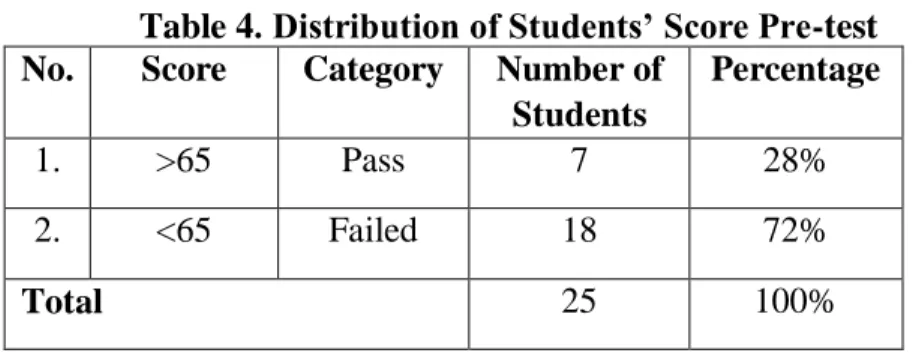
Interpretation
- The Result of Pre-Test
- Learning Result of Cycle 1
- Learning Result of Cycle 2
- Learning Result of the Cycle 1 and Cycle 2 a. Increasing the Students’ Activities
It could be seen that the teacher was already able to deliver the material chronologically and was able to make the students more active in the teaching-learning process. In students' activities of the first cycle, it showed that in each students' activity there is more increase. In the first cycle, the teacher's explanation increased from 40% to 52%, response to the teacher increased from 28% to 36%, the teacher's group exercise increased from 28% to 40%, and actively participates in ' a group at the first meeting 40% increased to 56%.
In the students' activities in the second cycle, in the first meeting the attention to the teacher's explanation was 60% and in the second meeting. Answers to the teacher increased from 56% to 68%, doing the group exercise from the teacher from 52% became 64%. This means that there are 19 students whose scores pass the minimum requirement (KKM), and there are 6 students who are below the target for the minimum requirement (KKM).
This class percentage showed some improvement of 76% from 28% pre-test or 48% post-test 1 in class. The Cycle 2 post-test met the Classroom Action Achievement (CAR) target of above 70% of students who could pass the minimum requirement (KKM). With the increase in student activity, it can be concluded that the percentage of student activity from the 1st and 2nd cycle has increased.
Pay attention to the teacher's explanation increased to 24%, response to the teacher increased to 30%, 24% do the group exercise by the teacher and 22% actively participate in the group.
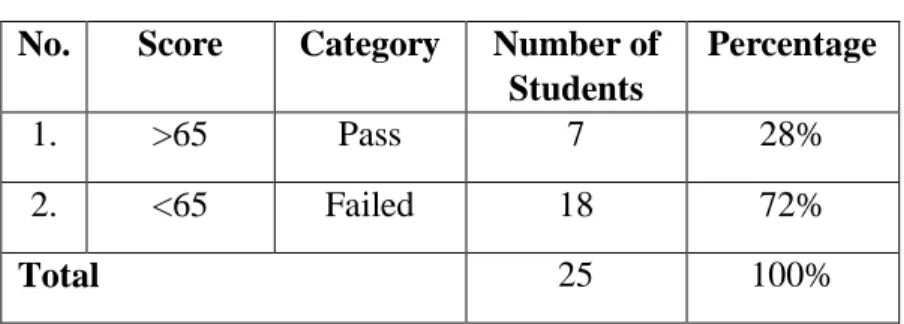
Conclusion
The Comparison Students' Score Pre-Test, Post-Test 1 and 2
Conclusion
This research uses the Classroom Action Research (KAR) to identify the problem on students. The number of students of the class is 25 students and through the interview English teacher. First the result of pre-test, there were 7 students (28%) who passed the minimum requirement (KKM).
Then, in the result of the post-test in the first cycle, there are 12 students (48%) in the class who passed the minimum requirement (KKM) as their average score of the test is 63.28. test in the second cycle, there are 19 students (76%) who passed the minimum requirement (KKM) in which their average score for the speaking ability test is 69.48. This means that the result of the second cycle has already reached the indicator of success, which is 70%.
Furthermore, the result of the observation showed that the students were more active and interested in learning the speaking activity in the classroom. It is approved by the result of the student observation sheet that has increased from 40% in the first cycle and. Based on the research conducted in the tenth grades of SMK YPI II Way Jepara East Lampung in the academic year it can be concluded that the Student Team Achievement Division (STAD) technique can increase their speaking ability.
Suggestion
Douglas Brown, 2000, Principles of Language Learning and Teaching Fourth Edition, San Francisco State University: Longman. Douglas Brown, 2000, Teaching by Principles an Interactive Approach to Language Pedagogy 2nd Edition, San Francisco State University: Longman. Jacobsen, David A., Eggen Paul and Kauchak Donald, 2009, terjemahan Methods For Teaching penerjemah: Achmad Fawaid dan Khoirul Anam, (New Jersey: . Pearson Education).
Richards, Jack C, 2001, Approaches and Methods in Language Teaching 2nd Edition, New York: Cambridge University Press. Singh, Yogesh Kumar, 2006, Fundamentals of Research Methodology and Statistics, New Delhi: New Age International Publisher. Robert, Terjemahan Cooperative Learning: Theory, Research and Practice (London: Allymand Bacon,2005) Description: Narulita Yusron, Bandung: Nusa Media.
